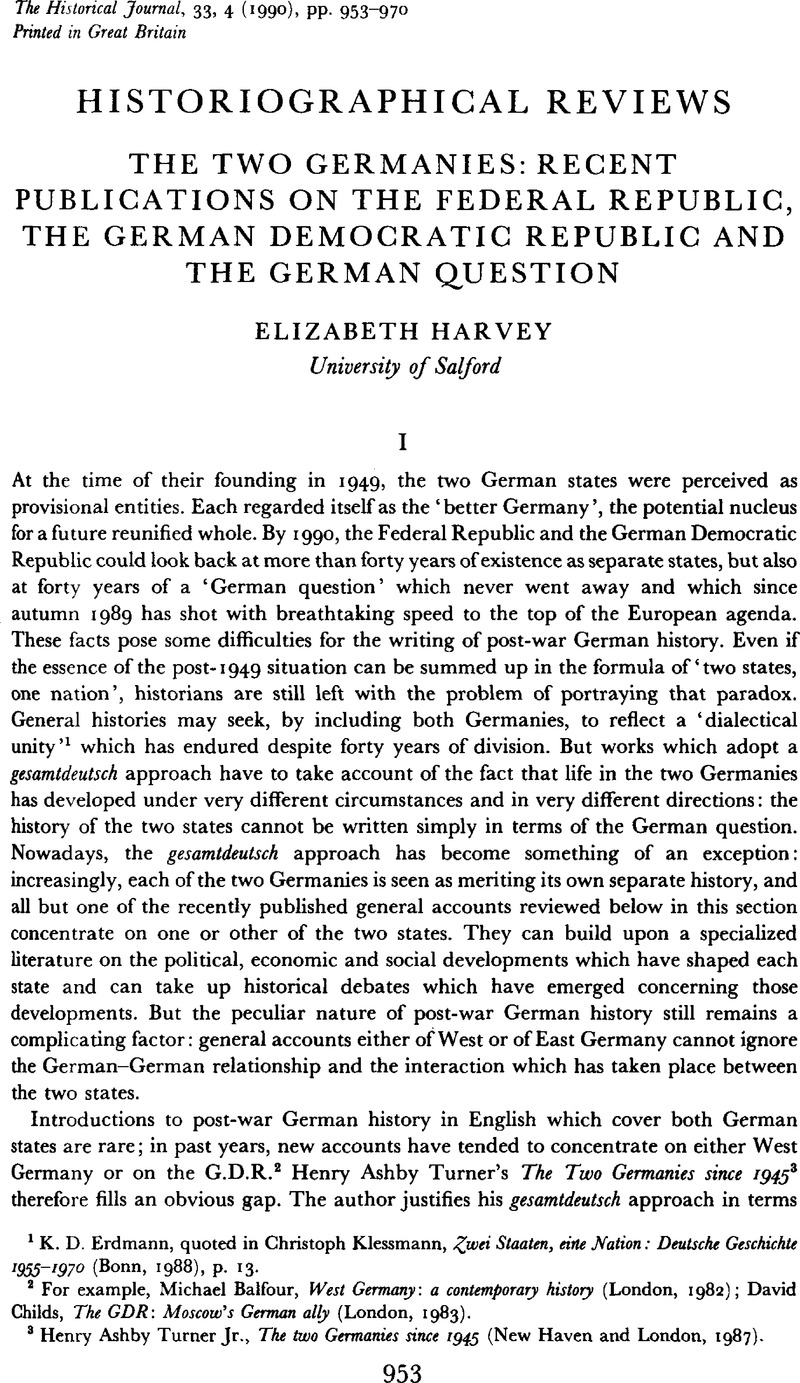No CrossRef data available.
Published online by Cambridge University Press: 11 February 2009

1 K. D. Erdmann, quoted in Klessmann, Christoph, Zwei Staaten, eine Nation: Deutsche Geschichte 1955–1970 (Bonn, 1988), p. 13Google Scholar.
2 For example, Balfour, Michael, West Germany: a contemporary history (London, 1982)Google Scholar; Childs, David, The GDR: Moscow's German ally (London, 1983)Google Scholar.
3 Turner, Henry Ashby Jr. , The two Germanies since 1945 (New Haven and London, 1987)Google Scholar.
4 Ibid. p. vii.
5 Weber, Hermann, Die DDR 1945–86 (Munich, 1988)Google Scholar.
6 Ibid. p. I.
7 His recent publications include Geschichte der DDR (Munich, 1985)Google Scholar and DDR: Dokumente zur Geschichte der Deutschen Demokratischen Republik 1945–1985 (Munich, 1986)Google Scholar.
8 Weber, , Die DDR 1945–86, pp. 86–7, 104Google Scholar.
9 Thomaneck, J. K. A. and Mellis, J. (eds.), Politics, society and government in the German Democratic Republic: basic documents (New York, Oxford and Munich, 1989), p. xiiiGoogle Scholar.
10 Ibid.
11 Schweitzer, C. C., Karsten, D., Spencer, R., Cole, R. T., Kommers, D. P. and Nicholls, A. J. (eds.), Politics and government in the Federal Republic of Germany: basic documents (Leamington Spa, 1984)Google Scholar.
12 Schneider, Franz (ed.), Der Weg der Bundesrepublik von 1945 bis zur Gegenwart (Munich, 1985)Google Scholar.
13 Morsey, Rudolf, Die Bundesrepublik Deutschland: Entstehung und Entwicklung bis 1969 (Munich, 1987)Google Scholar.
14 Ibid. p. 45.
15 Thränhardt, Dietrich, Geschichte der Bundesrepublik Deutschland (Frankfurt am Main, 1986)Google Scholar.
16 Ibid. p. 7.
17 Ibid. pp. 224–6.
18 See Klessmann, Christoph, ‘Ein stolzes Schiff und krächzende Möwen: Die Geschichte der Bundesrepublik und ihre Kritiker’, Geschichte und Gesellschaft, XI (1985) 476–94 (esp. 489–91)Google Scholar.
19 Among the main works based on this interpretation are Schmidt, Eberhard, Die verhinderte Neuordnung 1945–1952 (Frankfurt am Main, 1970)Google Scholar; Huster, Ernst-Ulrich et al. , Determinanten der westdeutschen Restauration 1945–1949 (Frankfurt am Main, 1972)Google Scholar; Pirker, Theo, Die verordnete Demokratie: Grundlagen und Erscheinungen der ‘Restauration’ (Berlin, 1977)Google Scholar.
20 Critics cited in Morsey, , Die Bundesrepublik Deutschtand, p. 145Google Scholar. See also Klessmann, Christoph, Die doppelte Staatsgründung: Deutsche Geschichte 1945–1955 (Göttingen, 1982), pp. 11–12Google Scholar.
21 Morsey, , Die Bundesrepublik Deutschland, pp. 141–6Google Scholar.
22 Thränhardt, , Geschichte der Bundesrepublik Deutschland, pp. 17–20Google Scholar. By contrast, Morsey, – Die Bundesrepublik Deutschland, pp. 142–5Google Scholar – casts doubt both on the view that socialization was strongly opposed by the American authorities and on the view that it was strongly supported by die German population.
23 Thränhardt, , Geschichte der Bundesrepublik Deutschland, pp . 22–3Google Scholar.
24 Ibid. pp. 39–42.
25 Marshall, Barbara, The origins of post-war German politics (London, 1988)Google Scholar.
26 Ibid. p. 181.
27 Ibid. p. 144.
28 Ibid. p. 151.
29 Ibid. p. 166.
30 Berghahn, Volker, The Americanisation of West German industry (Leamington Spa and New York, 1986)Google Scholar.
31 Ibid. p. 253.
32 Ibid. p. 331.
33 Abelshauser, Werner, Wirtschaftsgeschichte der Bundesrepublik Deutschland 1945–1980 (Frankfurt am Main, 1983), p. 8Google Scholar.
34 Morsey, , Die Bundesrepublik Deutschland, p. 114Google Scholar.
35 Abelshauser, Werner, Wirtschaft in Westdeutschland 1945–1948. Rekonstruktion und Wachstumbedingungen in der amerikanischen und britischen Zone (Stuttgart, 1975)CrossRefGoogle Scholar; idem, Wirtschaftsgeschichte der Bundesrepublik; idem, ‘Wiederaufbau vor dem Marshallplan. Europas Wachstumchancen und die Wirtschaftsordnungspolitik in der zweiten Hälfte der vierziger Jahre’, Vierteljahreshefte für Zeitgeschichte [VfZ], XXIX (1981), 545–78; ‘Ansätze “korporativer Marktwirtschaft” in der Koreakrise der fruüen fünfziger Jahre. Ein Briefwechsel zwischen dem Hohen Kommissar John McCloy und Bundeskanzler Konrad Adenauer (Dokumentation)’, VfZ, XXX (1982), 715–56Google Scholar; ‘Zur Funktion des Marshallplans beim westdeutschen Wiederaufbau’, VfZ, XXXVII (1989), 85–113Google Scholar.
36 Elements of Abelshauser's interpretation are adopted and quoted in, for example, Klessmann, Christoph, Die doppelte Staatsgründung, p. 223Google Scholar; Thränhardt, , Geschichte der Bundesrepublik Deutschland, pp. 66–7Google Scholar; Berghahn, , The Americanisation of West German industry, pp. 77–9Google Scholar.
37 Ritschl, Albrecht, ‘Die Währungsreform von 1948 und der Wiederaufstieg der westdeutschen Industrie’, VfZ, XXXIII (1985), 136–63Google Scholar; see also Abelshauser's, reply, ‘Schopenhauers Gesetz und die Währungsreform’, VfZ, XXXIII (1985), 214–18Google Scholar; Borchardt, Knut and Buchheim, Christoph, ‘Die Wirkung der Marshallplan-Hilfe in Schlüsselbranchen der deutschen Wirtschaft’, VfZ, XXXV (1987), 317–47Google Scholar; Klemm, Bernd and Trittel, Günter J., ‘Vor dem “Wirtschaftswunder”; Durchbruch zum Wachstum oder Lähmungskrise?’, VfZ, XXXV (1987), 571–624Google Scholar; Buchheim, Christoph, ‘Die Währungsreform 1948 in Westdeutschland’, VfZ, XXXVI (1988), 189–231Google Scholar.
38 Klump, Rainer, Wirtschaftsgeschichte der Bundesrepublik Deutschland. Zur Kritik neuerer wirtschaftshistorischer Interpretationen aus ordnungspolitischer Sicht (Wiesbaden, 1985)Google Scholar.
39 Ibid. pp. 70–1.
40 See note 35 above.
41 Klump, , Wirtschaftgeschichte, pp. 81–95Google Scholar.
42 Ibid. pp. 106–8.
43 Turner, , The two Germanies since 1945, p. 59Google Scholar.
44 Der Weg der Bundesrepublik, pp. 75–6.
45 Moreton, Edwina (ed.), Germany between east and west (Cambridge, 1987)Google Scholar.
46 Ibid. p. 9.
47 Ibid. p. 40.
48 Fritsch-Bournazel, Renata, Confronting the German question: Germans on the east–west divide (New York, Oxford and Munich, 1988)Google Scholar.
49 Ibid. p. 103.
50 Ibid. pp. 20–1.
51 Ibid. pp. 138–41.